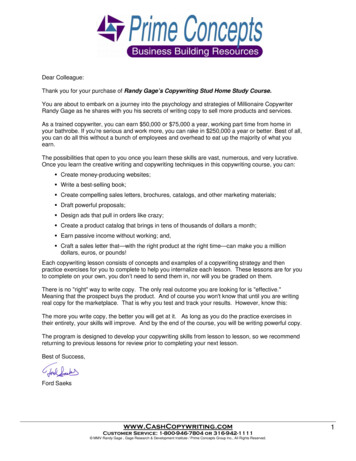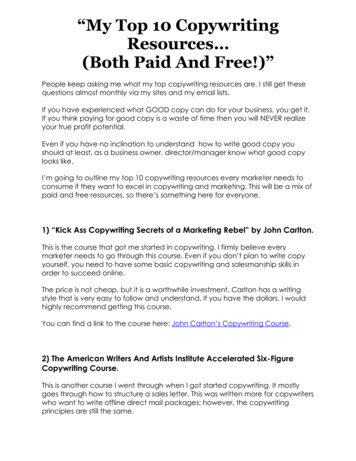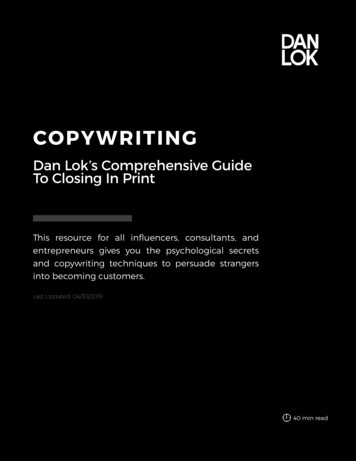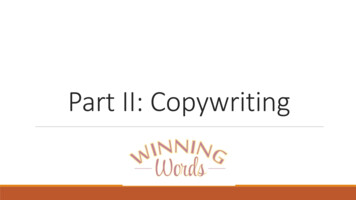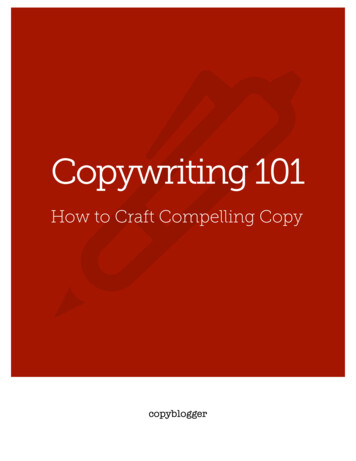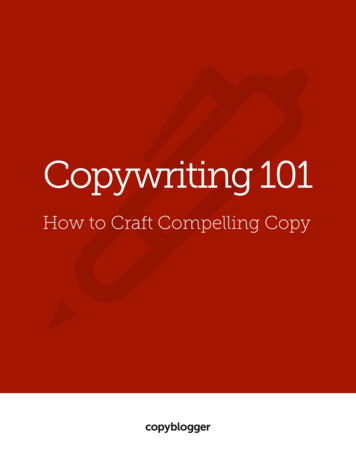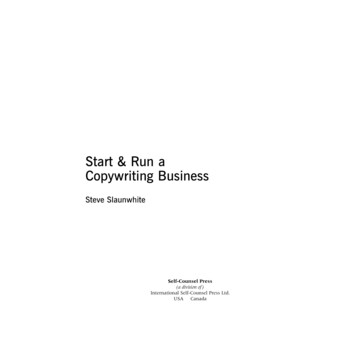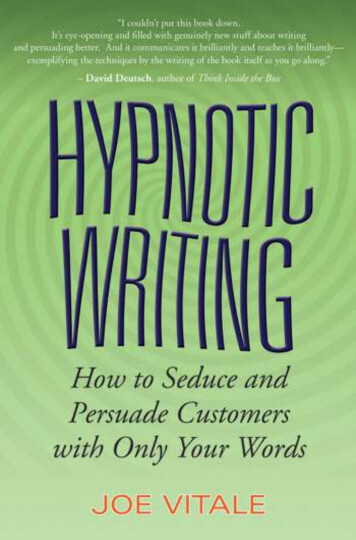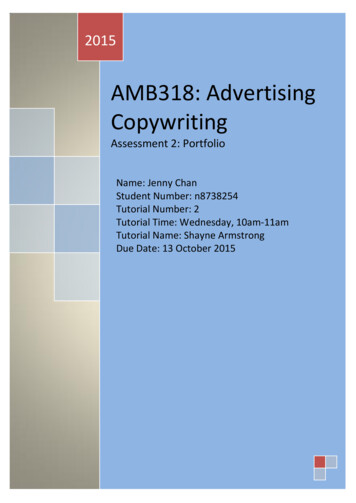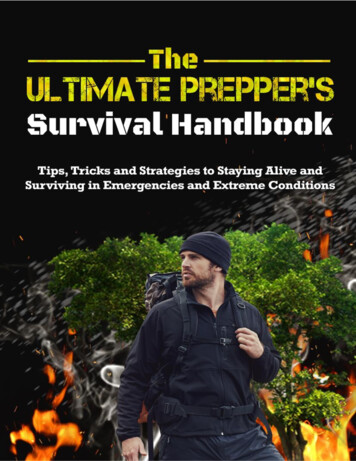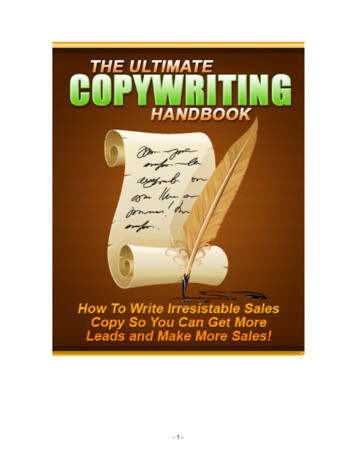
Transcription
-1-
DisclaimerThis e-book has been written to provide information about Internet marketing.Every effort has been made to make this ebook as complete and accurate aspossible. However, there may be mistakes in typography or content. Also, this ebook provides information on Internet marketing only up to the publishing date.Therefore, this ebook should be used as a guide - not as the ultimate source ofInternet Marketing information.The purpose of this ebook is to educate. The author and the publisher does notwarrant that the information contained in this e-book is fully complete and shallnot be responsible for any errors or omissions. The author and publisher shallhave neither liability nor responsibility to any person or entity with respect to anyloss or damage caused or alleged to be caused directly or indirectly by this ebook.-2-
Table of ContentsIntroduction . 5Basic Skills . 6How to Improve Your Writing Skills . 6Good Grammar is the Minimum . 6Style Trumps Grammar . 7Writing for Your Target Audience . 10Step #1: Research Your Audience . 11Step #2: Write for Your Audience . 12How to Sell Through Writing . 14Writing Good Headlines. 17Why a Headline Can Make or Break a Sales Letter . 1710 Different Techniques for Writing a Good Headline . 17Good Headline Examples . 19Testing and Tracking . 28Step #1: Define Your Experiment Carefully. 28Step #2: Hold All Else Constant . 29Step #3: Collect Large Samples . 29Step #4: Make a Decision . 29Powerful Tricks for Boosting Conversion Rates . 31How to Use Bullet Points Correctly. 31How to Use Sub-Headings . 32How to Correctly Use Bolding and Highlighting. 34Closing a Sale. 36Retaining Reader Interest . 36Using Calls to Action Correctly . 38Step #1: Tell The Reader Exactly What To Do . 39Step #2: Surround the Call to Action with Supporting Text . 39Step #3: Make it Easy to Follow Your Call to Action . 40The AIDA Method . 42Attention . 42Interest . 43Part #1: Introduce a Problem . 43Part #2: Introduce a Solution to the Problem . 44-3-
Decision . 45Action . 45The 30-Day Copywriting Plan . 46Week #1: Focus on Basic Skills & Market Research . 46Week #2: Complete Two Sales Letters . 46Week #3: Make Changes & Compile a Swipe File . 47Week #4: Polish Your Copy, Test, and Track . 48Week #5 and Beyond: Practice, Refine, Track, and Test . 49Conclusion. 50-4-
IntroductionIf you’re like most Internet marketers, you wouldn’t hire a copywriter for most ofyour projects—and for good reasons, too. First, you know that most of yourprojects are simply too small to bring in a high-powered copywriter and pay them 50-100 per page.And second, few others know your product and your market as well as you do.No matter how hard you try to convey important points about your product to thecopywriter, you know you’ll lose something in translation.So what can you do? Your first option is to continue to write sub-par copy formost of your sales letters; and simply hope that it will do the trick.However, if you’re more realistic with yourself, you’ll probably quickly see theproblem with doing this—namely, that you’re leaving hundreds or eventhousands of dollars on the table every time you create a sales page thatconverts 1%, rather than 2% or 3%.And this is precisely why you must learn the art of copywriting: it will not onlysave you money, but it will also ensure that you have a master copywriterworking on every project you initiate.In this ebook, I hope to help you develop a robust, powerful set of copywritingstrategies. I will not only show you how to improve your writing and your salesskills, but I will also give you a step-by-step, 30-day outline that you can use toguide you through the process.-5-
Basic SkillsAbove all else, mastering basic writing skills is important. No matter howpersuasive you are verbally, if you cannot put those words into clear, thoughtful,grammatically correct writing, your arguments may prove more off-putting thanenticing.And this is precisely why I recommend developing your basic writing skills beforeyou try to delve deep into copywriting and other forms of sales writing.How to Improve Your Writing SkillsGood Grammar is the MinimumWhen it comes to copywriting, no one is going to be impressed by your goodgrammar. In fact, no one will notice your grammar at all unless it is bad. And thisis precisely why it is important to think about good grammar being the startingpoint for any sales letter—not a lofty goal to achieve.If you have a weak background in writing, there’s a good chance you arefrequently making grammatical errors that most readers perceive as a poorreflection on you. For instance, you might use sentence fragments often; or youmight have subject-verb agreement issues. Either way, you are probablyrepeating these mistakes again and again without even noticing it.In fact, writers make these mistakes all the time. And when they do, it not onlymakes them look bad, but it can even confuse the reader by providing the wronginformation.-6-
So what can you do about it? You can start by identifying your areas ofweakness; and then practicing grammar drills to improve.Doing “grammar drills” isn’t on the top of the list of the things you want to spendyour weekend doing, but if you truly aspire to be a MASTER copywriter—not amediocre copywriter—you must start by mastering grammar first.When it comes to doing grammar drills, you have a number of options. Ipersonally recommend that you use one of the following three sites, all of whichprovide free information and drills:1. mar.htm2. http://dartmouth.edu/ writing/materials/student/ac paper/drills/index.shtml3. http://www.englisch-hilfen.de/en/exercises list/alle grammar.htmAs with most things in life, your time is probably best used concentrating on yourproblem areas. So, rather than re-learning English grammar in its entirety, youshould eliminate your weaknesses. You can use the following tests to identifywhich areas you should work on:1. http://www.world-english.org/diagnostic grammar.htm2. http://www.dailywritingtips.com/grammar-test-1/3. http://www.grammarbook.com/grammar quiz/grammar mastery.aspStyle Trumps Grammar-7-
When it comes to copywriting, good grammar is the bare minimum. It isexpected; and if you don’t have it, then many will dismiss your sales letteroutright.And, yet, going from good grammar to perfect won’t be enough to change yourconversion rate from 1% to 2%. Nor will a grammatically flawless headline keeppeople reading your sales letter with increasing attention.In fact, when it comes to improving your conversion rates, style—not grammar—is most important. When your style is weak, clunky, or disorganized, your readerswill stop paying attention and will eventually leave.And when your style is clear and riveting, readers will be drawn into your copy;and will want to read more. And this is why you must make an effort to improveyour style in addition to your grammar.What many don’t understand is that style improvements don’t occur magically.Style also isn’t a “talent” that you either have or don’t. Rather, you can improveyour style, just as you can improve your grammar.You can even purchase style guides that tell you exactly how to improve yourwriting according to a set of clear rules. However, before you buy any books, youshould start with the following set of ten rules:1. Avoid using clichés. Clichés are tiresome and create the impression ofuninspired, uncreative writing, so avoid using them where possible.2. List major points. Instead of spreading information throughout the body ofa document, summarize important points in a central location using bulletpoints.-8-
3. Give the reader directions. Rather than simply leaving your reader tofigure out what’s going on, give her hints about where she’s been, whereshe is, and where she’s going.4. Write in the active voice. Consider the following two statements: a) “Johncreated the website”; and b) “The website was created by John.” The firststatement is in the active voice, which is what you should try to adopt in allof your writing.5. Get rid of unnecessary qualifiers. Most style experts claim that words like“really” and “very” don’t add anything to writing, but often take away fromit. Try to avoid using them where possible.6. After you write the first draft, always try to reduce the size of the piece ofwriting, rather than adding to it. Cut out unnecessary sentences andclauses; and simplify constructions that are planning to keep.7. Keep sentences short and clear. Long, complicated sentences withconfusing constructions will do little other than baffle your readers.8. Avoid turning verbs into nouns. For instance, instead of saying “I had tomake a decision,” say “I had to decide.”9. Maintain a single voice. If you don’t maintain a single, coherent stylethroughout the piece of writing, it will be difficult for a reader to envisionyou as a person. When it comes to sales writing, it is critical that they cando this.10. Organize your writing. Organize the paper, including its sections,subsections, and paragraphs. A clear and organized purpose will make iteasier for the reader to pay attention to your writing.-9-
In addition to following these 10 style tips, you should also invest some time instyle drills; and in reading a style manual. One good fall-back is the classic “TheElements of Style,” which you can read for free at the following ting for Your Target AudienceOne of the most important parts of good writing is knowing and speaking to youraudience. Many novice Internet marketers who attempt to write copy do notconsider this at all. Rather, they simply craft a generic sales letter that soundsgenerally persuasive, but do not consider who will be reading it.Unfortunately, this error can be a fatal one (at least as far as your conversionrates go). If you fail to speak to the people who are reading your sales letter, thenyour campaign is unlikely to be successful, no matter how persuasive you believeit sounds.For a number of excellent examples of “speaking to your audience,” see thefollowing achieve of sales letters from the late Gary tter-archives.htmAmong other things, one thi
Therefore, this ebook should be used as a guide - not as the ultimate source of Internet Marketing information. The purpose of this ebook is to educate. The author and the publisher does not warrant that the information contained in this e-book is fully complete and shall not be responsible for any errors or omissions. The author and publisher shall have neither liability nor responsibility to .
